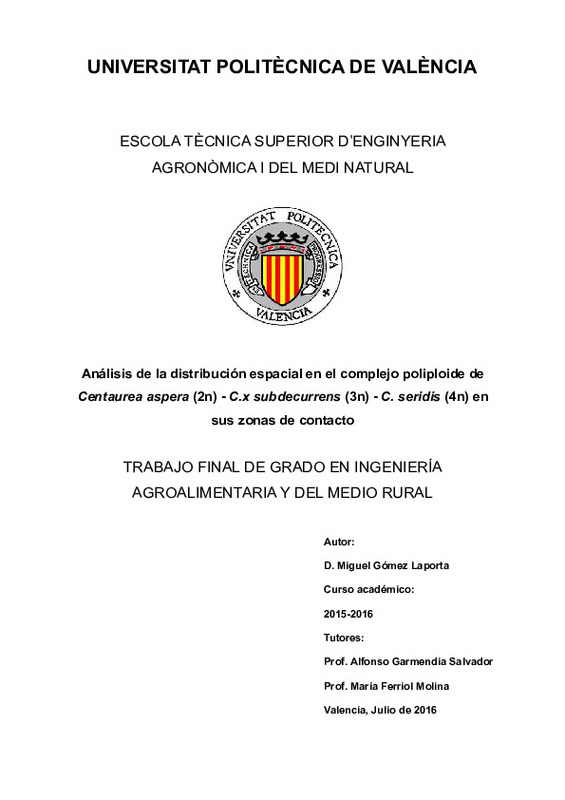|
Resumen:
|
[ES] El género Centaurea L. pertenece a la familia Asteraceae (Compositae). Esta familia es una de las más diversas, ya que incluye unos 1.620 géneros y más de 23.600 especies. Esta gran diversificación de Centaurea se ...[+]
[ES] El género Centaurea L. pertenece a la familia Asteraceae (Compositae). Esta familia es una de las más diversas, ya que incluye unos 1.620 géneros y más de 23.600 especies. Esta gran diversificación de Centaurea se produce en gran medida mediante mecanismos de poliploidización e hibridación. De hecho, la capacidad de hibridación en el género Centaurea es una de las más altas conocidas, afectando sobre todo a especies cercanas o de la misma sección (Mateo y Crespo, 2009).
A lo largo de la costa levantina tenemos la suerte de contar con uno de los complejos poliploides más interesantes de este género, producido por la hibridación de C. aspera subsp. stenophylla (2n), C. seridis subsp. maritima (4n) y su híbrido estéril C. x subdecurrens (3n). La genética y taxonomía de estos complejos híbridos han sido estudiados recientemente por el equipo de investigación que dirige este proyecto (Ferriol 2015 y anteriores) aunque las relaciones ecológicas y la distribución espacial a micro y meso escala todavía no están suficientemente estudiadas.
Ruíz (2014; Ruiz et al. 2014) ya realizó una primera aproximación a la distribución espacial a macro y microescala y estudió las condiciones del microhábitat de cada uno de los taxones de este complejo poliploide en el Saler, utilizando parcelas estrechas y alargadas para intentar dilucidad los gradientes asociados con la distancia al mar. En sus resultados se observa que este gradiente no es tan claro como se esperaba y que es necesario realizar parcelas mucho más grandes para poder determinar a qué escala se están produciendo los procesos de atracción (similitud de nicho) y repulsión (competencia) entre los tres taxones. Además, es necesario realizar análisis de la distribución de los taxones en todas las zonas donde coexisten, para comprobar si existen o no diferencias en los patrones de distribución y en las frecuencias de los distintos citotipos en función de la latitud (desde Chilches, en Castellón, hasta Calblanque, en Murcia).
Por ello, los objetivos del presente estudio son:
1. Comparar los patrones de distribución espacial en diferentes complejos híbridos de diferentes localidades, desde Chilches a Calblanque, pasando por la Marjal dels Moros, El Saler, Guardamar del Segura, Torrevieja (La Mata) y Santa Pola.
2. En cada una de estas localidades, realizar parcelas lo más grandes posible, de forma sistemática, para por un lado comparar las proporciones existentes de los tres taxones a lo largo de un gradiente latitudinal, y por otro lado poder observar los patrones de distribución de éstos a diferentes escalas.
Para ello se tomarán datos de posicionamiento en el campo para cada individuo y se realizarán los análisis estadísticos a través de la herramienta informática R, que permitirá relacionar la posición de los tres taxones entre ellos y en relación a parámetros ecológicos como distancia al mar o proximidad de caminos e infrastructuras.
Bibliografía citada en el Resumen:
Ferriol, María, Alfonso Garmendia, Ana Gonzalez, y Hugo Merle. (2015) «Allogamy-Autogamy Switch Enhance Assortative Mating in the Allotetraploid Centaurea seridis L. Coexisting with the Diploid Centaurea aspera L. and Triggers the Asymmetrical Formation of Triploid Hybrids». PLoS ONE 10:1-13.
doi:10.1371/journal.pone.0140465.
Ruiz, P. (2014)Distribución y microhábitat de Centaurea aspera (2n), C. seridis (4n) y C. x subdecurrens (3n) en la provincia de Valencia. TFC. UPV, Valencia, Marzo de 2014.
Ruiz, P., Garmendia, A., Ferriol, M., Merle, H. (2014) Distribución de Centaurea aspera (2n), C. seridis (4n) y su híbrido C. x subdecurrens (3n) a diferentes escalas. Eds: cámara R., Rodriguez B., Muriel JL., ¿Biogeografía de sistemas litorales. Dinámica y conservación¿. Pp: 409-412. Universidad de Sevilla.
[-]
[EN] The genus Centaurea L. belongs to the Asteraceae (Compositae) family. This family is one of the most varied, since it includes more than 1,620 kinds and more than 23,600 species. This great diversification of Centaurea ...[+]
[EN] The genus Centaurea L. belongs to the Asteraceae (Compositae) family. This family is one of the most varied, since it includes more than 1,620 kinds and more than 23,600 species. This great diversification of Centaurea occurs largely through mechanisms of hybridization and polyploidization. In fact, the ability of hybridization in the genus Centaurea is one of the highest known, affecting mostly closely related species or the same section (Matthew and Crespo, 2009).
Along the east coast we are lucky to have one of the most interesting polyploid complexes of this type produced by hybridization of C. aspera subsp. stenophylla (2n), C. seridis subsp. maritima (4n) and sterile hybrid C. x subdecurrens (3n). The genetics and taxonomy of these hybrid complexes have been recently studied by the equipment of investigation that directs this project (Ferriol 2015 and earlier) but the ecological relationships and spatial distribution at the micro and meso scale are still not sufficiently studied.
Ruíz (2014; Ruiz et to. 2014) already realized the first approximation to the spatial distribution to macro and it microscale and he studied the conditions of the microhabitat of each one of the taxones of this polyploid complex in the Saler, using plots narrow and elongated to try explain the gradients associated with the distance with the sea. In his results is observed that this gradient is not so clear as expected and that it is necessary to realize much bigger plots to be able to determine to what scale there are taking place the processes of attraction (similarity of niche) and repulsion (competition) between the three taxones. In addition, it is necessary to realize analysis of the distribution of taxa in all areas where coexist, to check whether there are or not differences in patterns of distribution and frequencies of the different citotypes depending on the latitude (from Chilches, in Castellón, up to Calblanque, in Murcia).
For it, the aims of the present study are:
1. Compare the patterns of spatial distribution in different complex hybrids of different localities, from Chilches to Calblanque, passing by the Marjal dels Moros, El Saler Guardamar del Segura, Torrevieja (La Mata) and Santa Pola.
2. In each of these localities, to realice plots the largest possible, of systematic form to compare the existing proportions of the three taxa along a gradient latitudinal, and on the other hand be able to observe the patterns of distribution of these at different scales.
For it there will take information of positioning in the field for every individual and the statistical analyses will be realized across the it computer tool R, that will allow to relate the position of the three taxa between them and in relation to ecological parameters such as distance to the sea or proximity of roads and infrastructure.
Bibliography cited in the summary
Ferriol, María, Alfonso Garmendia, Ana Gonzalez, y Hugo Merle. (2015) «Allogamy-Autogamy Switch Enhance Assortative Mating in the Allotetraploid Centaurea seridis L. Coexisting with the Diploid Centaurea aspera L. and Triggers the Asymmetrical Formation of Triploid Hybrids». PLoS ONE 10:1-13.
doi:10.1371/journal.pone.0140465.
Ruiz, P. (2014) Distribución y microhábitat de Centaurea aspera (2n), C. seridis (4n) y C. x subdecurrens (3n) en la provincia de Valencia. TFC. UPV, Valencia, Marzo de 2014.
Ruiz, P., Garmendia, A., Ferriol, M., Merle, H. (2014) Distribución de Centaurea aspera (2n), C. seridis (4n) y su híbrido C. x subdecurrens (3n) a diferentes escalas. Eds: cámara R., Rodriguez B., Muriel JL., ¿Biogeografía de sistemas litorales. Dinámica y conservación¿. Pp: 409-412. Universidad de Sevilla.
[-]
|








